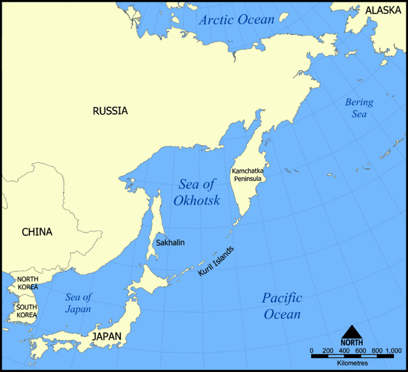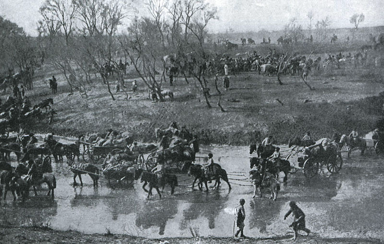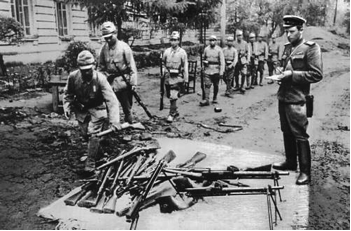My Solution to the Kuril Islands Problem
by Viacheslav Yatsko
part 1 of 2
Introduction
The impetus for this short essay was the bill adopted by the Japanese Parliament on July 3, 2009. It declared that the Kuril Islands “have always been Japanese territory.”
This decision raised strong objections on the Russian side.
The Ministry of Foreign Affairs issued a statement that characterized the decision of the Japanese Parliament as “inappropriate and unacceptable.”
The Russian parliament declared the peace treaty talks with Japan “pointless.”
The Federation Council, the upper chamber of the Russian parliament, has asked President Dmitry Medvedev to consider declaring a moratorium on the visa-free exchange between Russians living on the islands and the Japanese, which started in 1992.
The Head of the Federation Council, Sergey Mironov, told the Japanese daily newspaper Asahi in his turn that “the islands will never be Japan’s territory.”
On July 9, Russian President Dmitry Medvedev told Japanese Prime Minister Taro Aso during their meeting in L’Aquila on the sidelines of the G8 summit that the Japanese parliament’s decision on the Kuril Islands “did not foster an atmosphere of trust.”
About 750 residents of the Far Eastern city of Yuzhno-Sakhalinsk protested on Friday against Japan’s claim to four disputed Pacific islands. “The islands were, are and will be ours,” said Yuri Andreyev, acting chairman of the city’s council of WWII veterans.
We witness tension in relations between the two countries. The aim of this essay is to suggest a solution to the problem of the Kuril Islands that, I hope, will be acceptable to both the Russians and the Japanese.
Some Facts from History

|
This position is of strategic importance: the owner of the Kuril Islands and Sakhalin Island can fully control the Sea of Okhotsk, which washes the Russian continental coast. Apart from that, the Islands themselves and the Sea of Okhotsk are rich in natural resources, hence the long-lasting dispute between Russia and Japan.
The first confrontation between the two countries took place as early as 1811, when Russian Captain Vasily Golovnin and his crew, who stopped at Kunashir during their hydrographic survey, were captured by samurais. Because a Japanese trader, Takadaya Kahei, was also captured by a Russian vessel near Kunashir, Japan and Russia entered into negotiations to establish the border between the two countries.
The Treaty of Commerce, Navigation and Delimitation was concluded in 1855, and the border was established between Iturup and Urup. This border confirmed that Japanese territory stretched south from Iturup and Russian territory stretched north from Urup. Sakhalin remained a place where people from both countries could live. The Treaty of Saint Petersburg, in 1875, resulted in Japan’s relinquishing all rights to Sakhalin in exchange for Russia’s ceding to Japan all of the Kuril Islands north of Urup.
The situation changed drastically in the Russo-Japanese war of 1904-1905, when the Russian armies and fleet were completely defeated in the battles of Mukden and Zusima. In accordance with the Treaty of Portsmouth, Russia ceded the southern half of Sakhalin Island to Japan in addition to the Kuril Islands, which Japan already possessed.

Retreat of the Russian Army after the Battle of Mukden
|
The results of the war shocked Russian society and were one of the causes of the First Revolution of 1905, during which thousands of people were shot and hanged by troops of Czar Nicolas II. Having failed to stand against the foreign enemy, the Czar succeeded in waging war against his own people. It was a turning point in Russian history: frustration and contempt for the Czar and his family struck a mortal blow at the foundations of the Russian monarchy. The ultimate result was the Second Revolution, the Communists’ seizure of power, and the execution of Nicolas II.
The attitudes in Russian society at that time were well expressed in the poem by K. Balmont, a well known Russian poet. Here follows my very free and somewhat awkward translation of the first two stanzas.
Our Czar is Mukden, Our Czar is Tsushima,
He is a bloody, nasty spot
The stinking powder, relapsing fever
That leaves a smeary and dirty blot.
He is a freak of nature, blind, stupid,
Confinement, birch-rods, a cowardly man
The Czar is a gallows-bird good at shooting
His own people, the ones he likes to hang.
Russia evened the score during World War II.
At the Yalta Conference of 1945 the Soviet Union had agreed to Allied pleas to terminate its neutrality pact with Japan and enter World War II’s Pacific Theater within three months after the end of the war in Europe. On August 9, 1945 the Manchurian Strategic Offensive Operation began. Russian troops under the command of Marshal Vasilevsky inflicted a crushing defeat on the Japanese Kwantung Army under General Otsuzo Yamada, a force that numbered over six hundred thousand men.
On August 18-31, Soviet forces occupied the North and South Kurils and the whole of Sakhalin Island.

Japanese soldiers surrendering to the Red Army.
|
The Manchurian Strategic Offensive Operation, along with the atomic bombings of Hiroshima and Nagasaki, combined to force Japan’s surrender; they made it clear that Japan had no hope of holding out even in the Home Islands. Nevertheless, Japan never accepted Russian occupation of the Kurils and refused to sign a peace treaty with Russia.
In 1956, the Soviet leader Nikita Khrushchëv promised to return the Habomai and Shikotan islands to Japan in order to make a peace treaty possible. Negotiations between Russians and Japanese failed because of pressure on Japan from the USA, which was afraid that the Soviet Union would legally possess the Kuril Islands.
In 2004 Lavrov, President Putin’s Minister of Foreign Affairs, declared that Russia was ready to fulfill Khrushchëv’s promise to cede two of the Kuril Islands to Japan. The Japanese did not accept the proposal and demanded that Russia cede the four islands that they call the “Northern Territories.”
Russia and Japan still don’t have a peace treaty, which means that they are technically still in a state of war.
Argumentation
Both sides provide arguments to support their positions that can be summarized as follows.
Russian arguments
The native inhabitants of the Islands are Ainu people that have nothing in common with the Japanese. The Japanese invaded the Kurils, conducted ethnic cleansing, and decimated the ethnic population. Having displayed such brutality the Japanese don’t have any moral right to own the islands.
The name of the Islands, under which they are known all over the world, is of Russian origin. Kuril is a third person past tense of the verb kurit’ (smoke). This name was given to the Islands by Russian sailors who saw volcanoes emit smoke . Russia has priority in geographical discovery of the Islands.
In World War II, Japan was a faithful ally of fascist Germany. Russia had to deploy a more than one-million man army in the Far East instead of sending troops to the German front, which significantly increased Russian losses. The Japanese ambition was to occupy all the territory of Russia from the Far East to the Urals in accordance with preliminary agreement with Hitler.
Japan was defeated and must pay for it in the same way as Germany did. Germany, which had to cede to Russia the vast territory of Prussia, is not making any territorial claims. The territorial claims of Japan manifest its aggressive nature. If Russia cedes the four islands, Japan will demand the rest of the islands at once.
As soon as the Kurils are ceded the USA will build military bases on them to deprive Russia of control over the Sea of Okhotsk and greatly undermine Russia’s security on the whole.
Ceding the islands will cause unrest in Russian society, and the political leaders responsible for it will be treated as traitors who have outraged the honor of Russian soldiers killed in the wars with Japan.
Japanese arguments
The Kurils came under the Japanese jurisdiction in the 16th century, while Russians appeared there in the 18th century, i.e. two hundred years later. The Russians have always used this territory to build temporary settlements to hunt otters, to fish, to exhaust the natural recourses of the surrounding seas. They didn’t lift a finger to build infrastructure, communications, capital constructions, and houses as the Japanese did. They don’t have any historical rights to this territory.
The Kurils comprise 6,140 square miles of islands populated by 16,800 people, which averages fewer than 3 persons per square mile. Most of these people live in striking poverty indecent in a civilized society. The Russian government hasn’t cared for these territories or the people living there.
Japan is overpopulated; it desperately needs these territories to expand its Lebensraum. The Japanese will not banish Russians living in the Islands, as the Russian occupation army did with the Japanese inhabitants in 1945. Japan can provide these people with decent living standards or pay substantial compensation to those who decide to move to Russia so that they will be able to buy good houses and start businesses or get an education.
The decision to cede the islands will solve the territorial problem forever. The peace treaty will be immediately signed and significantly improve bilateral economic and political relations. Russia will greatly benefit from large-scale Japanese investments, which will help increase living standards in the Russian Far East.
According to the treaty signed by President Putin in 2004, Russia ceded to China several big islands in the Amur River without getting any distinct profit. Why wouldn’t it cede the Kuril Islands to Japan to get important political and economic advantages?
The argumentation shows how deep the contradictions between the positions of two sides are, how unlikely agreement is, and how important it is to suggest a solution acceptable to both sides.
Copyright © 2009 by Viacheslav Yatsko
